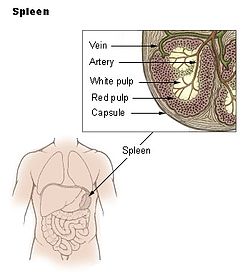Spleen
| Spleen | |
|---|---|
 | |
| Spleen | |
 | |
| Laparoscopic view of a horse's spleen (the purple and grey mottled organ) | |
| Latin | Lien (Greek: Splen) |
| Gray's | subject #278 1282 |
| Artery | Splenic artery |
| Vein | Splenic vein |
| Nerve | Splenic plexus |
| Precursor | Mesenchyme of dorsal mesogastrium |
| MeSH | Spleen |
| Dorlands/Elsevier | Spleen |
The spleen (from Greek σπλήν—splḗn[1]) is an organ found in virtually all vertebrate animals. Similar in structure to a large lymph node, it acts primarily as a blood filter. It is possible toremove the spleen without jeopardizing life. The spleen plays important roles in regard to red blood cells (also referred to as erythrocytes) and the immune system.[2] It removes old red blood cells and holds a reserve of blood, which can be valuable in case of hemorrhagic shock, and also recycles iron. As a part of the mononuclear phagocyte system, it metabolizeshemoglobin removed from senescent erythrocytes. The globin portion of hemoglobin is degraded to its constitutive amino acids, and the heme portion is metabolized to bilirubin, which is removed in the liver.[3]
The spleen synthesizes antibodies in its white pulp and removes antibody-coated bacteria and antibody-coated blood cells by way of blood and lymph node circulation. A study published in 2009 using mice found that the spleen contains, in its reserve, half of the body's monocyteswithin the red pulp.[4] These monocytes, upon moving to injured tissue (such as the heart), turn into dendritic cells and macrophages while promoting tissue healing.[4][5][6] The spleen is a center of activity of the mononuclear phagocyte system and can be considered analogous to a large lymph node, as its absence causes a predisposition to certain infections.[7]
In humans, the spleen is brownish in color and is located in the left upper quadrant of the abdomen.[3][8]
Structure[edit]
The spleen, in healthy adult humans, is approximately 7 centimetres (2.8 in) to 14 centimetres (5.5 in) in length. It usually weighs between 150 grams (5.3 oz)[9] and 200 grams (7.1 oz).[10] An easy way to remember the anatomy of the spleen is the 1×3×5×7×9×11 rule. The spleen is 1" by 3" by 5", weighs approximately 7 oz, and lies between the 9th and 11th ribs on the left hand side.
Like the thymus, the spleen possesses only efferent lymphatic vessels. The spleen is part of the lymphatic system. Both the short gastric arteries and the splenic artery supply it with blood.[11]
The germinal centers are supplied by arterioles called penicilliary radicles.[12]
Development[edit]
The spleen is unique in respect to its development within the gut. While most of the gut viscera are endodermally derived (with the exception of the neural-crest derived suprarenal gland), the spleen is derived from mesenchymal tissue.[13] Specifically, the spleen forms within, and from, thedorsal mesentery. However, it still shares the same blood supply—the celiac trunk—as the foregut organs.
Function[edit]
| Area | Function | Composition |
| red pulp | Mechanical filtration of red blood cells. In mice: Reserve of monocytes[4] |
|
| white pulp | Active immune response through humoral and cell-mediated pathways. | Composed of nodules, called Malpighian corpuscles. These are composed of:
|
Other functions of the spleen are less prominent, especially in the healthy adult:
- Production of opsonins, properdin, and tuftsin.
- Creation of red blood cells. While the bone marrow is the primary site of hematopoiesis in the adult, the spleen has important hematopoietic functions up until the fifth month of gestation. After birth, erythropoietic functions cease, except in some hematologic disorders. As a major lymphoid organ and a central player in the reticuloendothelial system, the spleen retains the ability to produce lymphocytes and, as such, remains an hematopoietic organ.
- Storage of red blood cells, lymphocytes and other formed elements. In horses, roughly 30% of the red blood cells are stored there. The red blood cells can be released when needed.[14] In humans, up to a cup (236.5 ml) of red blood cells can be held in the spleen and released in cases of hypovolemia.[15] It can store platelets in case of an emergency. Up to a quarter of lymphocytes can be stored in the spleen at any one time.
- In mice, the spleen stores half the body's monocytes so that upon injury they can migrate to the injured tissue and transform into dendritic cellsand macrophages and so assist wound healing.[4]
Decreased function[edit]
Asplenia refers to a non-functioning spleen, which may be congenital or due to surgical removal. These may cause:[5]
- modest increases in circulating white blood cells and platelets,
- diminished responsiveness to some vaccines,
- increased susceptibility to infection by bacteria and protozoa; in particular, there is an increased risk of sepsis from polysaccharide encapsulated bacteria. Encapsulated bacteria inhibit binding of complement or prevent complement assembled on the capsule from interacting with macrophage receptors. Natural antibodies are required for phagocytosis, which are immunoglobulins that facilitate phagocytosis either directly or by complement deposition on the capsule. They are produced by IgM memory B cells in the marginal zone of the spleen.[16][17] Splenectomy greatly diminishes the frequency of memory B cells.[18]
A 28-year follow-up of 740 veterans of World War II who had their spleens removed on the battlefield found that those who had beensplenectomized showed a significant excess of mortality from pneumonia (6 rather than the expected 1.3) and a significant excess of mortality from ischemic heart disease (4.1 rather than the expected 3) but not from other conditions.[19]
'연구하는 인생 > Natural Therapy' 카테고리의 다른 글
| How to Cleanse the Spleen (0) | 2014.03.01 |
|---|---|
| The Liver and Spleen (0) | 2014.03.01 |
| Pancreas Cleanse (0) | 2014.03.01 |
| How Does a Pancreases Cleanse Work? (0) | 2014.02.28 |
| Healthy Liver, Pancreas Cleansing (0) | 2014.02.28 |
